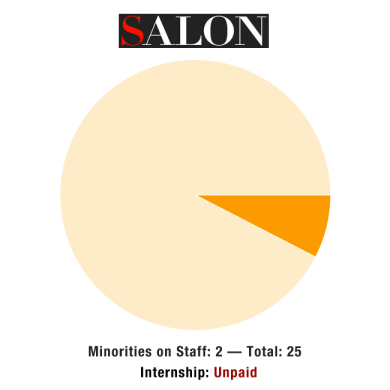CofCC
May 15, 2014

The very people who scream “racism” day after day after day, and claim to be the champions of non-whites, do not want to give non-white jobs at their media outlets. The percentage of non-whites on newspaper staffs shrunk between 2008 and 2012. Even then, many of the non-whites are Asian. Meaning that blacks and Latinos are extremely under-represented.
American Prospect Magazine basically outed itself, and fellow lefties for lacking the diversity they claim to champion.
Some of the most shrill left-wing Magazine/Websites, who relentlessly scream about “racism,” have the smallest percentage of non-whites. The the dinosaur left-wing newspaper industry shrinks, and jobs become fewer, white leftists have lost all interest in promoting racial diversity in their own industry.
This is kinda like when Tim Wise says that white people have unfairly earned to much wealth and must be forced to share it with blacks. Yet Wise, who is far wealthier than the average white person, says he earned his own money through merit and explicitly states that he shouldn’t have to share his own wealth with anyone.
Among the worst offenders:
The Nations: 4.2% Non-white
Salon.com: 8% non-white
Slate.com: 12% non-white
American Prospect suggests that the social networks of journalists tends to be disproportionately white and disproportionately Jewish, giving those groups the upper hand. While non-whites may shy away from such a white dominated industry.
At newspapers, the percentage of minorities on staff decreased from 13.73 to 12.37 percent between 2008 and 2012. Anecdotally, the downturn has had a similar effect on the magazine world. Magazine editors offered several explanations for the whitewashing: Publications shrank to their core leadership, cutting off positions in the lower echelons, where members of minority groups are more likely to find themselves; people of color and members of other minority groups disproportionately took buyouts.
In the struggle to stay afloat, worrying about diversity came to be seen as quaint. “Up until 2008, newsrooms—especially large ones—were really really conscious about diversity,” says Slate editor David Plotz, whose publication’s staff composition of 75 is about 6.7 percent minority. “The recession made newsrooms very miserly thinking about issues like that. The thinking was, ‘We are in survival mode, we are about saving our jobs. This is not an issue we care about.’”
…
This highlights another key reason the country’s leading think publications lack diversity: the industry’s reliance on social networks for hiring. The people we know—professionally and personally—tend to have similar backgrounds, and so when editors cast the net to build up the applicant pool for a position, they are largely recruiting people who look and think like themselves. The payroll at the outlets included in this piece draw heavily from the Ivy League or similarly selective institutions. “The original writing and editing batch at Slate came from elite college folks of the old [former TNR editor] Michael Kinsley New Republic tradition, folks who work there came out of that and tended to be white and Jewish and Northeastern,” Plotz says. “That perpetuates itself—it’s hard to look for and find people who are not like you.” Making matters worse, many outlets don’t advertise open positions, instead relying on their circle of professional contacts to fill slots.
If magazines want to make their staffs more inclusive, it requires more than good intentions and a broad commitment to diversity. “To use the 12-step language, first you have to name the problem,” says Monika Bauerlein, co-editor of Mother Jones, which has improved diversity in the past several years through concerted recruiting efforts, yielding 12.5 percent of its 40-person staff who are members of racial and ethnic minority groups. “Diversity is something that we emphasize in every posting and that we look to as an important part in the candidates that we talk to.”
So what happens if you stress diversity and still end up with an applicant pool that is almost exclusively white? “If you care about a diverse newsroom, you need to constantly be looking down the pipeline,” says Ann Friedman, former deputy editor at the Prospect. “It requires you to be actively looking for new staff members, not just perusing the résumés that roll in.” That means looking outside one’s existing social network and actively asking minorities to apply. When the pool of applicants for the Prospect’s writing fellowship was male and nearly entirely white, Friedman says she turned to the blogosphere, which is where the magazine found talented writers like Adam Serwer and Jamelle Bouie. “There are all sorts of nonwhite, nonmale writers all over the Internet,” Friedman says.
Besides scouring the Internet, magazines can also increase the number of people of color who apply for fellowships and positions by reaching out to journalism departments at historically black colleges and Latino-serving institutions as well as professional organizations like the National Association of Black Journalists, the National Association of Hispanic Journalists, and the Asian American Journalists Association. But the work doesn’t stop there. “Even after you find someone you think will be a good fit in your newsroom, if your newsroom is mostly white and male and straight, you’ll probably have to convince them they’ll be welcome,” Friedman says.
